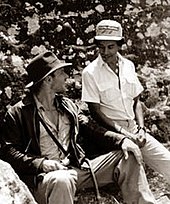Filming[edit]
Huyck later recalled "at one point when we were writing it we told George “We know a lot of Indians. We've been there... I don't think they're going to think this is really so cool. Do you think you're going to have trouble shooting there?” He said, “Are you kidding? It's me and Steve." Months later they called and said, “We can't shoot in India. They're really upset.” So they shot in Sri Lanka and London, mostly.”[16]
The filmmakers were denied permission to film in North India and Amer Fort due to the government finding the script offensive.[8][12][15] The government demanded many script changes, rewritings and final cut privilege.[3] As a result, location work went to Kandy, Sri Lanka, with matte paintings and scale models applied for the village, temple, and Pankot Palace. Budgetary inflation also caused Temple of Doom to cost $28.17 million, $8 million more thanRaiders of the Lost Ark.[15] Filming began on April 18, 1983 in Kandy,[17] and moved to Elstree Studios in Hertfordshire, England on May 5. Producer Frank Marshall recalled, "when filming the bug scenes, crew members would go home and find bugs in their hair, clothes and shoes."[17] Eight out of the nine sound stages at Elstree housed the filming of Temple of Doom. Lucas biographer Marcus Hearn observed, "Douglas Slocombe's skillful lighting helped disguise the fact that about 80 percent of the film was shot with sound stages."[18]
Danny Daniels choreographed the opening music number "Anything Goes". Capshaw learned to sing in Mandarin and tooktap dance lessons. However, when wearing her dress, which was too tight, Capshaw was not able to tap dance. Made of the 1920s and 1930s original beads, the dress was one of a kind. The opening dance number was actually the last scene to be shot, but the dress did feature in some earlier location shots in Sri Lanka, drying on a nearby tree. Unfortunately an elephant had started to eat it, but some was salvaged. Consequently, some emergency repair work had to be done with what remained of the original beads, and it was costume designer Anthony Powell who had to fill in the insurance forms. As to the reason for damage, he had no option but to put "dress eaten by elephant".[12]
Norman Reynolds could not return for Temple of Doom because of his commitment to Return of the Jedi. Elliot Scott (Labyrinth, Who Framed Roger Rabbit), Reynolds' mentor, was hired. To build the rope bridge the filmmakers found a group of British engineers working on the nearby Balfour Beatty dam.[3] Harrison Ford suffered a severe spinal disc herniation by performing a somersault while filming the scene with the assassin in Jones' bedroom. A hospital bed was brought on set for Ford to rest between takes. Lucas stated, "He could barely stand up, yet he was there every day so shooting would not stop. He was in incomprehensible pain, but he was still trying to make it happen."[8] With no alternatives, Lucas shut down production while Ford was flown to Centinela Hospital on June 21 for recovery.[17] Stunt double Vic Armstrong spent five weeks as a stand-in for various shots. Wendy Leach, Armstrong's wife, served as Capshaw's stunt double.[19]
Macau was substituted for Shanghai,[15] while cinematographer Douglas Slocombe caught fever from June 24 to July 7 and could not work. Ford returned on August 8. Despite the problems during filming, Spielberg was able to complete Temple of Doom on schedule and on budget, finishing principal photography on August 26.[17] Various pick-ups took place afterwards. This included Snake River Canyon, in Idaho, Mammoth Mountain, Tuolumne and American River, Yosemite National Park, San Joaquin Valley, Hamilton Air Force Base and Arizona.[2] Producer Frank Marshall directed a second unit in Florida in January 1984, using alligators to double as crocodiles.[2][13] The mine chase was a combination of a roller coaster and scale models with dolls doubling for the actors.[15] Minor stop motion was also used for the sequence. Visual effects supervisors Dennis Muren, Joe Johnston and a crew at Industrial Light & Magic provided the visual effects work,[20] while Skywalker Sound, headed by Ben Burtt, commissioned the sound design. Burtt recorded Willie Scott's scream and roller coasters at Disneyland Park in Anaheim for the mine cart scene.[21]
Editing[edit]
"After I showed the film to George [Lucas], at an hour and 55 minutes, we looked at each other," Spielberg remembered. "The first thing that we said was, 'Too fast'. We needed to decelerate the action. I did a few more matte shots to slow it down. We made it a little bit slower, by putting breathing room back in so there'd be a two-hour oxygen supply for the audience."[2]


No comments:
Post a Comment